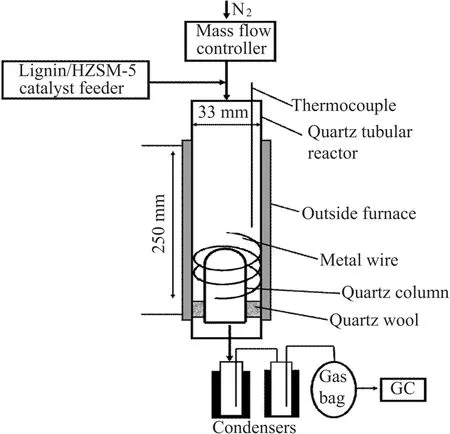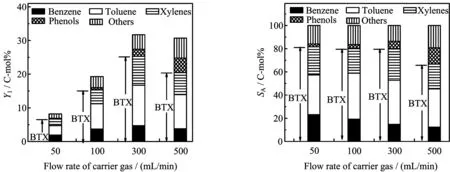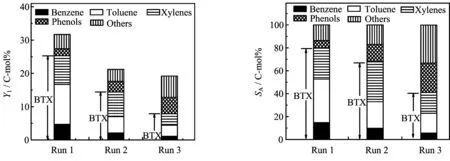Production of BTX through Catalytic Depolymerization of Lignin
2014-07-18MinghuiFnShumeiDengTiejunWngQunxinLi
Ming-hui Fn,Shu-mei Deng,Tie-jun Wng,Qun-xin Li∗
a.Department of Chemical Physics,University of Science and Technology of China,Hefei 230026, China
b.Key Laboratory of Renewable Energy and Gas Hydrate,Guangzhou Institute of Energy Conversion, Chinese Academy of Sciences,Guangzhou 510640,China
(Dated:Received on August 28,2013;Accepted on November 11,2013)
Production of BTX through Catalytic Depolymerization of Lignin
Ming-hui Fana,Shu-mei Denga,Tie-jun Wangb,Quan-xin Lia∗
a.Department of Chemical Physics,University of Science and Technology of China,Hefei 230026, China
b.Key Laboratory of Renewable Energy and Gas Hydrate,Guangzhou Institute of Energy Conversion, Chinese Academy of Sciences,Guangzhou 510640,China
(Dated:Received on August 28,2013;Accepted on November 11,2013)
Lignin is the only nature renewable resource which can provide large quantities of aromatic compounds.In the work,transformation of lignin into benzene,toluene,and xylenes(BTX) was investigated over the HZSM-5,HY,and MCM-22 catalysts,and the HZSM-5 catalyst showed the highest carbon yield of BTX.The reaction condition,including temperature,the gas f l ow rate,and the catalyst/lignin ratio,was also investigated.The carbon yield of BTX reached about 25.3 C-mol%over HZSM-5 catalyst under T=550◦C,f(N2)=300 cm3/min, and catalyst/lignin ratio of 2.
Lignin,Benzene,Toluene,Xylenes,Depolymerization
I.INTRODUCTION
Biomass is an important feedstock for the renewable production of fuels,chemicals,and energy.Lignin,together with cellulose and hemicelluloses,is the major component of lignocellulosic biomass.Lignin is by far the most abundant substance composed of aromatic moieties in nature[1].The global paper industry produced over 50 million tons/year and the second generation ethanol fuel using the crop waste produced a large amount of lignin as by-product[1-3].In the plant cell walls,lignin serves to maintain the integrity of the cellulose/hemicellulose/pectin matrix.Composition,molecular weight,and amount of lignin dif f er from plant to plant.In softwood lignin represents about 30% of the total mass,while in hardwood the share falls to 20%-25%[2].Cellulose consists of long linear f i brils of β-(1,4)-glucopyranoside chains and hemicelluloses is branched polysaccharides composed of 1,4-linked β-D-hexosyl residues.Lignin exhibits distinctly dif f erent macromolecular structure which is polymerized through three primary phenylpropane monomers-coniferyl alcohol,sinapyl alcohol,and coumaryl alcohol.The composition of softwood and hardwood lignin also varies in the relative abundance of the p-coumaryl,coniferyl, and sinapyl alcohols.The linkages in lignin structure include β-O-4,5-5,β-5,4-O-5,β-1,dibenzodioxocin,and β-β linkages,of which the β-O-4 linkage is dominant, consisting of more than half of the linkage structures of lignin[1-6].
Benzene,toluene,and xylenes(BTX)are important aromatic platform compounds which can be hydrogenated to alkanes or used in the synthesis of other fi ne chemicals such as fi ber,rubber,dyestu ff,coatings and pesticide[1].The annual output of BTX is one of the important symbols to measure a country’s development in the petrochemical industry.By now, the production process of BTX is deeply dependent on petrochemical industry but in order to cope with the increasing energy consumption of fossil fuel and environmental problems,alternative renewable sources are now investigated by many institutions across the world.Much e ff ort has been devoted to fi nding appropriate method to produce BTX from bio-resource[7-9]. As the lignin macromolecule consisted of methoxylated phenylpropane structures,the removal of the extensive functionality of the lignin subunits can provide a route to produce BTX[3].
Products derived from the lignin generally contain a wide range of compounds such as phenols,aromatic hydrocarbons,alkanes,and low oligomers[4,10-14].Disruption of the complicated lignin polymer into smaller subunits is an important step for lignin cracking.Catalysis is considered as a key enabling technology for biomass conversion in general and for ful fi lling the promise of lignin valorization in particular[1].Zeolites represent the most important inorganic materials for catalysis and more than 180 di ff erent structural types of zeolites have been already recognized and the individual types of zeolites di ff er in the size of the channels[15].The conversion of lignin into BTX can go through the reactions occurring inside the zeolite such as dehydration,decarboxylation,decarbonylation,hydrogen transfer,alkylation,isomerization and aromatization[3,16].Several catalysts such as HZSM-5,Y-zeolite,Al-MCM-22,β-zeolite,H-USY,SPA and Al-MSU catalysts can serve to crack lignin into low molec-ular weight compounds[15-26].The performances of the catalysts mentioned above are strongly dependent on structural characteristics of the catalyst,including the presence and strength of acid sites and framework [3,15].Jackson and co-workers investigated several zeolite catalysts for the pyrolysis of lignin and HZSM-5 produced the highest yield of deoxygenated liquid fraction with high yield of aromatic compounds and naphthenic compounds relative to other zeolites[27].So the challenge is to f i nd a way to improve the yield of target products[28].
In this work,we used the renewable lignin to produce the important aromatic platform compounds-BTX,and studied the transformation of lignin into BTX through the catalytic depolymerization of lignin into aromatic monomers and the highest carbon yield reached about 25.3 C-mol%over HZSM-5 catalyst under the optimum reaction condition.This transformation may potentially provide an approach for the production of BTX and the development of aromatic platform compounds using the renewable lignin.
II.EXPERIMENTS
A.Feedstocks
The brown and sulfur-free lignin powder was manufactured from wheat straw,and purchased from Lanxu Biotechnology Co.Ltd.(Hefei,China).Dried lignin mainly consists of 62.55%carbon,29.91%oxygen,5.89%hydrogen,and 1.65%nitrogen,measured by an elemental analyzer(Vario EL-III,Elementar,Germany).Analytical reagents such as ethanol,acetone benzene,toluene,xylenes,and phenol were purchased from Sinopharm Chemical Reagent Company Limited in China(Shanghai,China).
B.Catalysts and characterization
Di ff erent kinds of zeolites such as HZSM-5,MCM-22, and HY-zeolite were supplied by Nankai University catalyst Co.,Ltd.,and catalysts were calcined in nitrogen atmosphere at 550◦C for 4 h prior to use.The elemental contents of these catalysts were measured by inductively coupled plasma and atomic emission spectroscopy (ICP/AES,Atomscan Advantage,Thermo Jarrell Ash Corporation,USA).The catalysts were investigated by BET(Brunauer-Emmett-Teller surface area)and NH3-TPD(temperature programmed desorption of ammonia)analyses.The N2adsorption/desorption isotherms of the catalysts were measured at-196◦C using the COULTER SA 3100 analyzer.For the NH3-TPD tests,the catalysts were dried in a vacuum oven for 12 h prior to test.Then the catalyst samples were heated to 500◦C under helium fl ow(ultrahigh purity, 100 mL/min)for 2 h.The adsorption of ammonia was carried out at 120◦C for 1 h.After the catalysts were fl ushed with He at 120◦C for 1 h to expel the unabsorbed ammonia,the programmed-desorption of NH3was run from 120◦C to 700◦C with a heating rate of 10◦C/min.Gas chromatograph(GC-SP6890,Shandong Lunan Ruihong Chemical Instrument Co.,Ltd., Tengzhou China)were used to measure the desorbed ammonia with a thermal conductivity detector(TCD).

FIG.1 The experimental setup for catalytic depolymerization of lignin.
C.Experimental setups and procedures
Figure 1 shows the reaction device used for catalytic depolymerization of lignin.The basic building blocks of the system are a tube reactor(inner diameter:33 mm; length:500 mm),a solid reactants feeder,two condensers,and a gas analyzer.Exclusion of oxygen was carried before each experiment by fl ushing the tube with nitrogen at a fl ow rate of 300 cm3/min for 2 h, then heated to target temperature by the carborundum heater(10◦C/min).The reactant sample was made by mixing the dried lignin powder and catalyst (40-60 mesh)at di ff erent weight ratio,and the solid mixture was then fed into the reactor by the feeder in 30 min.The stability of the catalyst was also studied. For run 1,10 g lignin powder and 20 g fresh HZSM-5 were continuously fed into the reactor with a feeding rate of 30 g lignin/h.After the reaction,the HZSM-5 was separated from the solid residue and was used for the next run.
Gas products were analyzed using a gas chromatograph(GC-SP6890,Shandong Lunan Ruihong Chemical Instrument Co.,Ltd.,Tengzhou,China)with two detectors.H2,CO,CH4and CO2were separated on TDX-01 column,and were analyzed by TCD(thermal conductivity detector).The gas hydrocarbons products were analyzed by FID( fl ame ionization detector).The liquid products(oil and water)in each test were collected by two liquid nitrogen/ethanol bath condensersand then weighed to obtain the mass of liquid products.The main components of the organic liquid products were analyzed by GC-MS(Thermo Trace GC/ISQ MS,USA)and the total carbon contents in the liquid products were measured by a Vario EL III elemental analyzer.Water content was analyzed by a moisture analyzer(Model ZSD-1,Shanghai,China).For GC-MS analysis,the liquid components such as benzene,toluene,xylenes were determined by the calibrated GC-MS peak area with the standard samples. We also measured the solid residues by the TGA analysis(Q5000IR thermogravimetric analyzer,USA)after cooling to room temperature in a N2f l ow when the experiment was over.

TABLE I Main characteristics of the catalysts used in this work∗.

FIG.2 Catalytic depolymerization of lignin using dif f erent catalysts at T=550◦C,f(N2)=300 cm3/min,and catalyst/lignin ratio of 2.
Carbon yield(Yl(C-mol%))of a specif i c product, and aromatic selectivity(SA(C-mol%))were calculated based on Eqs.(1)and(2)[29].

where xl,xa,and xAare carbon moles in a product, an aromatic product,and aromatics respectively,and xfedis carbon moles fed in.Each datum was the mean values based on three tries.
III.RESULTS AND DISCUSSION
A.Catalyst screening for lignin depolymerization
The comparative tests of the transformation of lignin into BTX were performed using three dif f erent zeolite catalysts(Table I).As shown in Fig.2,in absence of catalyst,only small amount of BTX was formed by thermal cracking and the main components in the liquid product were phenols’mixtures. However,the carbon yields of BTX were notably enhanced as the zeolite catalysts were used.The catalytic depolymerization of lignin with dif f erent zeolites decreased in the following order:HZSM-5>MCM-22>HY-zeolite.Using HZSM-5 gives the highest carbon yield of BTX(25.3 C-mol%).The BTX selectivity using HZSM-5(pore size:0.53 nm×0.56 nm), MCM-22(poresize:0.71 nm×0.71 nm)andHY (pore size:0.74 nm×0.74 nm)were 79.8 C-mol%, 76.5 C-mol%and67.7C-mol%,respectivelyat T=550◦C,f(N2)=300 cm3/min,and catalyst/lignin ratio of 2.Among the tested catalysts,HZSM-5 gives both the highest BTX carbon yield and BTX selectivity. The strong acidity of HY(2206µmol/gcat.)and MCM-22(610µmol/gcat.)are benef i cial to produce more coke than that over HZSM-5,leading to a decrease of carbon yield of BTX.
B.Ef f ect of temperature on transformation of lignin

FIG.3 Ef f ect of temperature on depolymerization of lignin to BTX over the HZSM-5 catalyst at f(N2)=300 cm3/min and catalyst/lignin ratio of 2.

FIG.4 Ef f ect of the catalyst/lignin ratio on the production of BTX from lignin over HZSM-5 at f(N2)=300 cm3/min.
Temperature has an important ef f ect on the catalytic transformation of the lignin to BTX with the selected HZSM-5 catalyst.As shown in Fig.3,the aromatic selectivity of BTX increases from 30.8 C-mol% to 90.9 C-mol%in our experiments which has a positive dependence on the reaction temperature.For the formation of the aromatic monomers,the ether/carboncarbon bonds of lignin were disrupted and then further deoxygenation over the catalyst.But extremely high temperatures over 550◦C will lead to the second cracking of organics liquid,giving a slight decrease of BTX carbon yield from 25.3 C-mol%at 550◦C to 24.1 C-mol%at 600◦C.The formation of phenols and heavier aromatics was signif i cantly decreased when rising the reaction temperature,indicating that the phenols and the heavier aromatics were further converted into smaller aromatic monomers through the removal of the groups in the aromatic rings(such as methyl,hydroxyl and methoxy groups)at higher temperature.Naphthalene and methylnaphthalene were also observed,due to the oligomerization reactions of lighter aromatics.
Temperature also strongly impacted the distribution of the products.The end products were divided into three categories:liquid organics(mainly BTX),gaseous products and coke.With increasing the reaction temperature,the carbon yield of organic liquid decreased from 38.3 C-mol%to 26.5 C-mol%due to the second cracking of organics liquid to form gas products, mainly consisting of CO,CO2,CH4,C2-C4 alkanes and C2=-C4=olef i ns.The oxygen element in the lignin was mainly removed by decarbonylation and dehydroxylation reactions to form CO,CO2,and H2O. The carbon yield of gaseous products increased from 15.2 C-mol%at 450◦C to 28.1 C-mol%at 600◦C,indicating that the deoxygenation and cracking processes were enhanced as the temperature increases.Moreover, the formation of coke decreased with increasing temperature.
C.Ef f ect of the catalyst/lignin ratio on the production of BTX from lignin
Catalyst plays an important role in the process of depolymerization and the ultimate organic liquid has a very low yield of BTX without the addition of catalyst (see Fig.2).The inf l uence of the weight ratio of catalyst to lignin on the production of BTX is presented in Fig.4.Both the carbon yield and the carbon selectivity of BTX were improved when the catalyst/lignin ratio increased from 1:1 to 2:1.It was found that the BTX selectivity showed a positive dependence on the catalyst/lignin ratio.Further increasing the catalyst/lignin by 3:1,however,the BTX yield showed a slight decrease, which accounted for an increase in yield of gas products and a decrease in liquid yield.The optimal ratio of catalyst to lignin is about 2:1 for production of BTX.

FIG.5 The inf l uence of carrier gas f l ow rate on the production of BTX from lignin over HZSM-5 at T=550◦C and catalyst/lignin ratio of 2.

FIG.6 Catalyst stability in lignin depolymerization over the HZSM-5 at T=550◦C,f(N2)=300 cm3/min and catalyst/lignin ratio of 2.
D.Inf l uence of f l ow rate of carrier gas on the production of BTX
The fl ow rate of carrier gas also has important impact on production of BTX from lignin.As shown in Fig.5,the BTX selectivity was about 81.7 C-mol%at the lower fl ow rate of 50 mL/min,and gradually decreased with an increase in fl ow rate to 500 mL/min. This means that increasing reaction time via varying fl ow rate will enhance the BTX selectivity through the catalytic depolymerization of lignin.
On the other hand,the weight yield of the organic liquid dramatically increased from 5.9%to 23.3%as the fl ow rate rising from 50 mL/min to 300 mL/min, accompanied by the decrease in the BTX yield from 6.7 C-mol%to 79.8 C-mol%.It was noticed that the weight yield of gas products increased from 20.4%to 39.8%when the fl ow rate changed from 500 mL/min to 50 mL/min.A low carrier gas fl ow rate had a long residence time in the catalytic reaction zone and enhanced the gasi fi cation of the organic liquid via the serious secondary cracking of aromatic products, mainly forming CO,CO2,gas alkanes and ole fi ns. Thus,the carrier gas fl ow rate should be kept at a higher level for production of BTX from lignin.
E.Catalyst stability
As shown in Fig.6,the catalyst stability of HZSM-5 in the lignin depolymerization was test under the optimum reaction condition(T=500◦C,f(N2)=300 mL/min and catalyst/lignin ratio of 2).The carbon yield of BTX signif i cantly decreased from 25.3 C-mol%to 7.9 C-mol% after HZSM-5 was used for three runs(run 1,run 2 and run 3).The yield of BTX selectivity over the used HZSM-5 obviously reduced to about 41.1 C-mol%for run 3.The loss of the catalyst activity mainly attribute to the decrease in the acidity and the surface area of the HZSM-5.Although we separated the most of coke from used HZSM-5 after each run,the residual coke on the catalyst surface may also occupy part of the active center and this negative impact on the performance of catalytic depolymerization will be depressed by the catalyst regeneration in our future work.
IV.CONCLUSION
Production of benzene,toluene,and xylenes(BTX) from lignin was investigated via the catalytic depolymerizaton of lignin using dif f erent zeolitie catalysts under various reaction condition.HZSM-5 shows the best results as the moderate acidity,and the small poresize are benef i cial for lignin cracking and the deoxygenation process.Temperature inf l uences distribution of products seriously,and the selectivity of BTX increases as the temperature rising.But high temperature will lead to the second cracking to form alkanes and olef i ns.The BTX selectivity showed a positive dependence on the catalyst/lignin ratio,and the optimal ratio of catalyst to lignin was about 2:1.Further increasing the catalyst/lignin ratio will decrease the BTX yield, which accounts for an increase in yield of gas products.And we need to carefully control the reaction time in order to obtain more BTX.The highest carbon yield and selectivity of BTX reached 25.3 C-mol% and 90.9 C-mol%over HZSM-5 catalyst at T=550◦C, f(N2)=300 cm3/min,and catalyst/lignin ratio of 2. Formation of BTX proceeded through lignin depolymerizaton followed by the deoxygenation process.Production of BTX from lignin can be potentially served as high-valued chemicals for the petrochemical industry.
V.ACKNOWLEDGMENTS
This work was supported by the National Key BasicProgramofChina(No.2013CB228105)and the National Natural Science Foundation of China (No.51161140331).
[1]J.Zakzeski,P.C.A.Bruijnincx,A.L.Jongerius,and B.M.Weckhuysen,Chem.Rev.110,3552(2010).
[2]F.G.Calvo-Flores and J.A.Dobado,ChemSusChem. 3,1227(2010).
[3]P.Sannigrahi,Y.Pu,and A.Ragauskas,Curr.Opin. Environ.Sustainability 2,383(2010).
[4]D.K.Shen,S.Gu,K.H.Luo,S.R.Wang,and M.X. Fang,Bioresour.Technol.101,6136(2010).
[5]F.Chakar and A.Ragauskas,Ind.Crop.Prod.20,131 (2004).
[6]R.N.Olcese,J.Francois,M.M.Bettahar,D.Petitjean, and A.Dufour,Energy Fuels 27,975(2013).
[7]B.Valle,A.G.Gayubo,A.T.Aguayo,M.Olazar,and J.Bilbao,Energy Fuels 24,2060(2010).
[8]H.J.Park,K.H.Park.J.K.Jeon,J.Kim,R.Ryoo. K.E.Jeong,S.H.Park,and Y.K.Park,Fuel 97,379 (2012).
[9]G.W.Huber and A.Corma,Angew Chem.Int.Ed.46, 7184(2007).
[10]M.Kleinert,J.R.Gasson,and T.Barth,J.Anal.Appl. Pyrolysis 85,108(2009).
[11]F.A.Agblevor,S.Beis,O.Mante,and N.Abdoulmoumine.Ind.Eng.Chem.Res.49,3533(2010).
[12]W.Y.Xu,S.J.Miller,P.K.Agrawal,and C.W.Jones, ChemSusChem 5,667(2012).
[13]J.Zakzeski,A.L.Jongerius,and B.M.Weckhuysen, Green Chem.12,1225(2010).
[14]N.Yan,C.Zhao,P.J.Dyson,C.Wang,L.T.Liu,and Y.Kou,ChemSusChem 1,626(2008).
[15]N.˘Zilkov´a,M.Bejblov´a,B.Gil,S.I.Zones,A.Burton, C.Y.Chen,Z.Musilov´a-Pavla˘ckov´a,G.Ko˘sov´a,and J,˘Cejka.J.Catal.266,79(2009).
[16]G.Sena-Martins,E.Almeida-Vara,and J.C.Duarte. Ind.Crop.Prod.27,189(2008).
[17]K.Giannakopoulou,M.Lukas,A.Vasiliev,C.Brunner, and H.Schnitzer,Bioresour Technol.101,3209(2010).
[18]M.Olazar,R.Aguado,J.Bilbao,and A.Barona, AIChE J.46,1025(2000).
[19]P.Wang,S.Zhan,H.Yu,X.Xue,and N.Hong,Bioresour Technol.101,3236(2010).
[20](a)R.Rinaldi and F.Sch¨uth,Energy Environ Sci.2, 610(2009). (b)E.Putun,B.B.Uzun,and A.E.Putun,Energy Fuels 23,2248(2009).
[21]H.Zhang,R.Xiao,D.Wang,Z.Zhong,M.Song,Q. Pan,and G.He,Energy Fuels 23,6199(2009).
[22]F.A.Agblevor,S.Beis,O.Mante,and N.Abdoulmoumine,Ind.Eng.Chem.Res.49,3533(2010).
[23]T.R.Carlson,T.R.Vispute,and G.W.Huber,Chem-SusChem 1,397(2008).
[24]T.Q.Hoang,X.Zhu,T.Danuthai,and L.L.Lobban, Energy Fuels 24,3804(2010).
[25]J.Jae,G.A.Tompsett,A.J.Foster,K.D.Hammond, S.M.Auerbach,R.F.Lobo,and G.W.Huber,J.Catal. 279,257(2011).
[26]D.M.Alonso,J.Q.Bond,and J.A.Dumesic,Green Chem.12,1493(2010).
[27]M.A.Jackson,D.L.Compton,and A.A.Boateng,J. Anal.Appl.Pyrolysis 85,226(2009).
[28]Z.Ma,E.Troussard,J.A.Bokhoven,Appl.Catal.A 423,130(2012).
[29]W.W.Huang,F.Y.Gong,M.H.Fan,Q.Zhai,C. G.Hong,and Q.X.Li,Bioresour.Technol.121,248 (2012).
∗Author to whom correspondence should be addressed.E-mail:liqx@ustc.edu.cn
杂志排行
CHINESE JOURNAL OF CHEMICAL PHYSICS的其它文章
- Spectral Shift of π→π∗Transition for p-Nitroaniline Based on a New Expression of Nonequilibrium Solvation Energy
- Insight into Capture of Greenhouse Gas(CO2)based on Guanidinium Ionic Liquids
- Electronic Structures,DNA-binding,SAR,and Spectral Properties of Ruthenium Methylimidazole Complexes[Ru(MeIm)4L]2+(L=iip,tip,2ntz)
- Theoretical Study on Dissociation Mechanisms of Di-ethyl Berylliums and Di-t-butyl Berylliums
- Inf l uence of pH Value on Photocatalytic Activity of Bi4Ti3O12Crystals Obtained by Hydrothermal Method
- N2O Decomposition over K-Ce Promoted Co-M-Al Mixed Oxide Catalysts Prepared from Hydrotalcite-like Precursors
